Two Player Showcase – Raptor and Pagoda
August 18, 2017I want to give a big shout out to David Wiley @CardboardClash on Twitter. He inspired me to do some two player game coverage. Check out his own reviews at cardboardclash.wordpress.com where he covers two and one player experiences playing games. He has a great list of games he has covered. What I like best about his reviews is that he covers games with higher player counts, but focuses on the two player side. Which is interesting since quite often a game that is two to four players, for example, can suck at the the lowest player count. So it’s very helpful getting a perspective on how that particular count plays. Go check him out and give him a follow on twitter if you haven’t already. And now onto the overview of raptor!
Raptor is an asymmetrical, card driven game where one player plays as the mother raptor, and the other player plays as the scientists. The scientists win if they capture three baby raptors or if they shoot the mother raptor with five sleeping darts. The mother raptor wins if she can get three of her babies to one of the four exits on the board, or if she eats every scientist on the board.
The game board consists of six double sided, square tiles, arranged in a two by three grid. These tiles have nine spaces on them, some of which might be an open space that allows figures to move into or out of it, or it could be a boulder space. The boulder spaces restrict movement and line of sight.
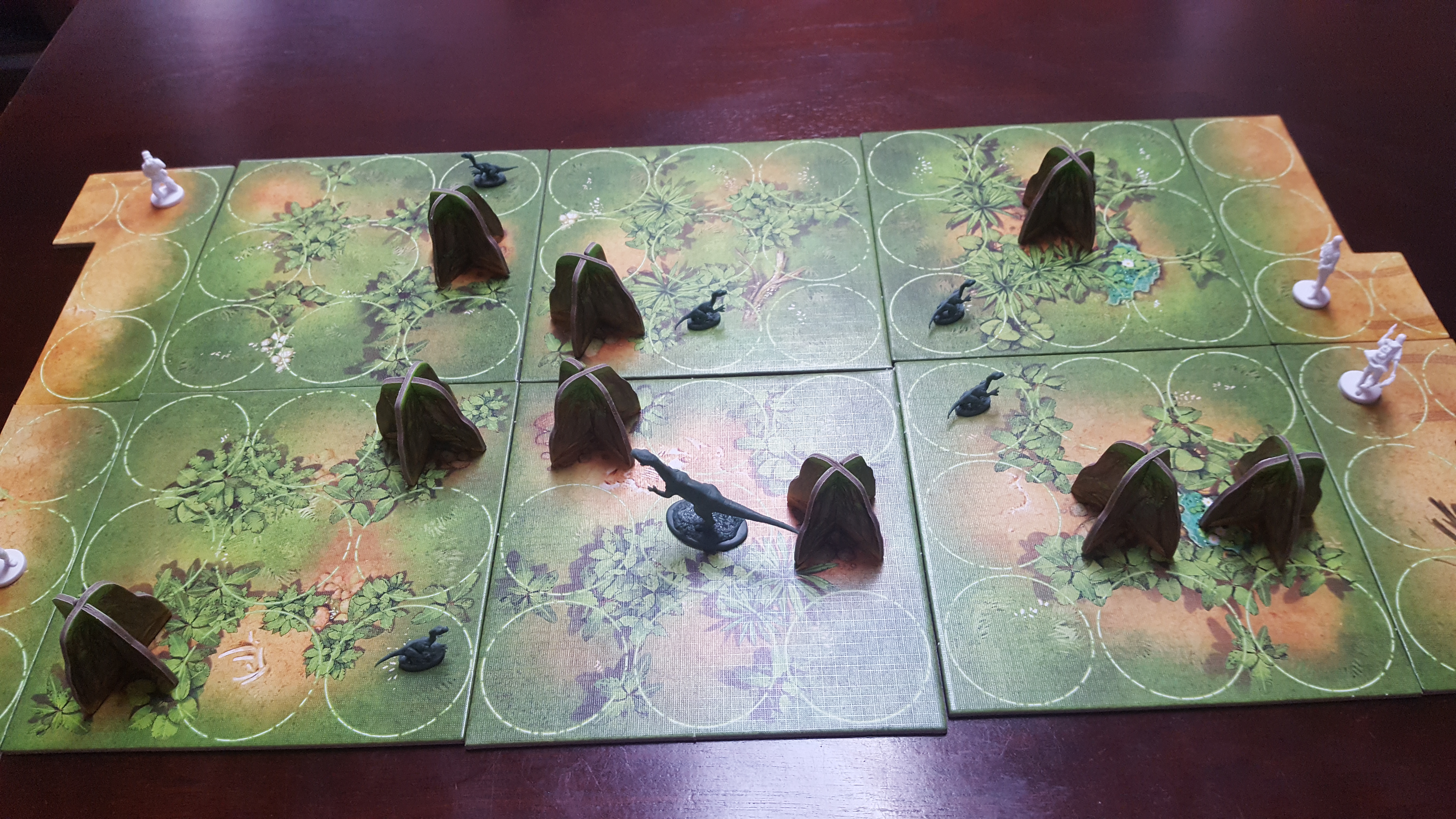
Initial setup of the board
In addition to the square tiles, there are four “L” shaped tiles that are placed at the short ends of the board. These tiles each contain the exit spaces for the baby raptors. They are also where the scientist player will place their four starting scientist figures, one scientist per “L” shaped tile. This is done after the raptor player chooses one of the middle tiles to place the mother raptor figure on. They will also place one baby raptor figure on each of the remaining five tiles. All six square tiles should now have one raptor figure on them.
Each player has their own deck of cards numbered one to nine. Players will always have a hand of three cards. They each choose one of these three cards to play and simultaneously reveal them. Whoever played the lower numbered card gets to to take the special ability of the card played. The player who played the higher numbered card gets to spend action points equal to the difference of the two cards played.
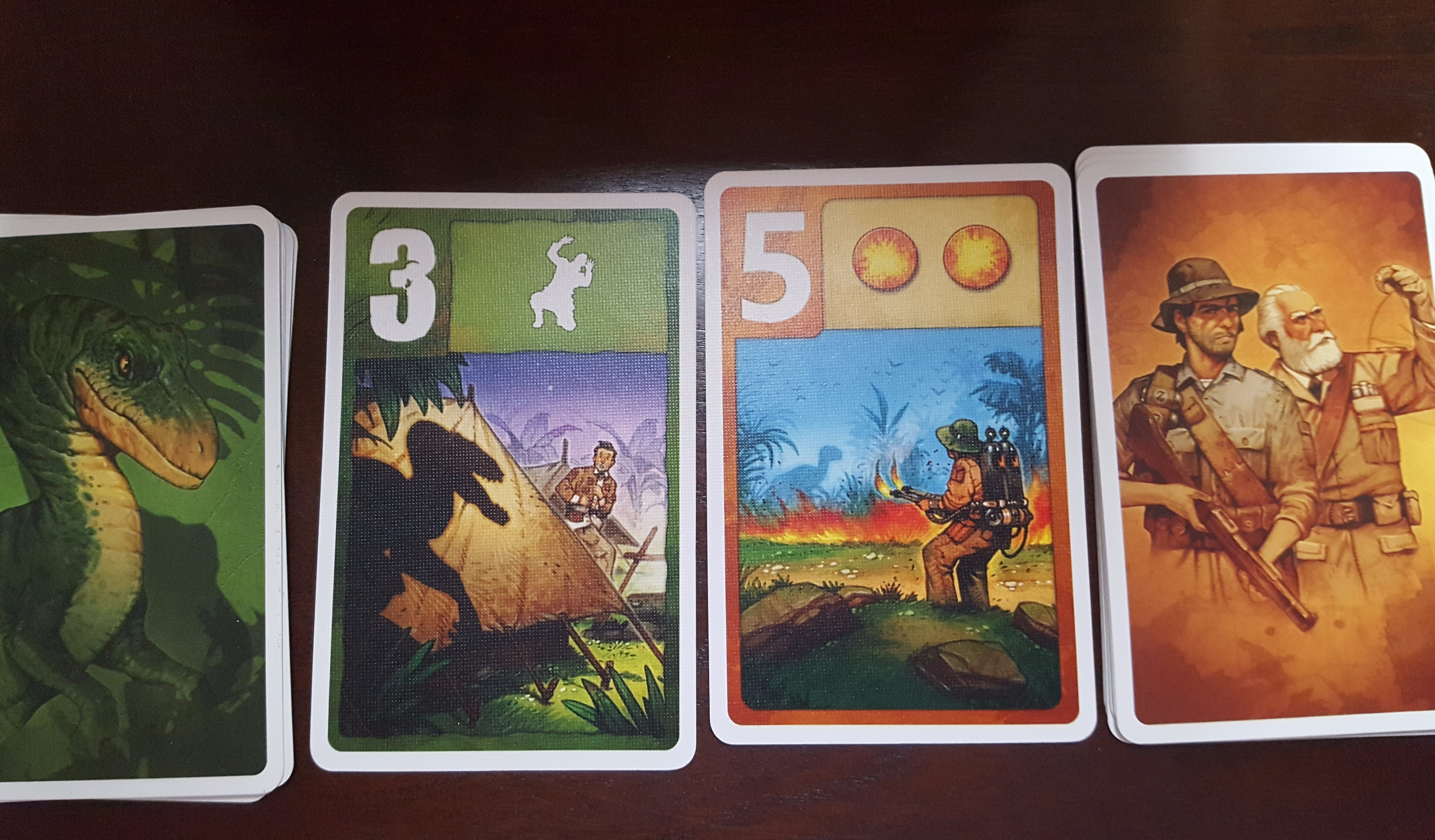
ex. of card play
Ex. The raptor players plays the ‘three’ valued card, and the scientist plays the ‘five’ valued card. The raptor player gets to use the special ability to frighten one scientist. They turn one scientist figure on its side to indicate that it is frightened. The scientist player then gets to spend two action points of their choice from the list of available actions found on their player board. They spend one action to move a scientist one space. Now they have line of sight to the mother raptor, so they will shoot her with a sleeping dart, using the second action point.
Players then draw back up to a hand of three cards, shuffling their discard pile if they run out of cards. Play continues until one side reaches their victory condition.
I’m a huge fan of asymmetrical games, even though they often have some sort of imbalance that can be exploited by an experienced player. But I am a bit of a glutton for punishment when it comes to games like this and seem to relish in the challenge of playing the “underdog”.
Raptor is one of those games. It seems to me that the game is favoured to the scientist player. I’ve played at least thirty games as the raptor player (that stubbornness and refusal to back down kicking in) and won less than five of them. I’ve played roughly fifteen games as the scientist side and lost two of them. The vast majority of these games were against the same opponent too, both of us having learned the game together.
Hardly reliable facts, I know, but I’m here to drop some mad anecdotal knowledge bombs on your ass. It is incredibly difficult to win as the raptor player. And that may leave a sour taste in your mouth. But for me, it just makes me want to play that side even more, over and over again, obsessively so, until I pull out a satisfying win. Like I said, I’m a glutton for punishment. I’ll get back to where I think that imbalance comes from, but for now I want to rave about the good stuff in this game.
First off, I really like the components. It’s a super simple game with not much in the box, but it’s all good quality stuff. Sturdy and thick tiles, linen finished cards. The miniatures are little dinky things, but they’re perfect for the size of the game and are not the focus. They could’ve just been cardboard tokens and would have served the same purpose, so I like that they’re included.
And the board is modular which helps with replayability. You can swap the tile locations around within the two by three grid and rotate them so the boulders are in a different orientation. And you can even flip them all over to get a different terrain with different configurations of boulders.
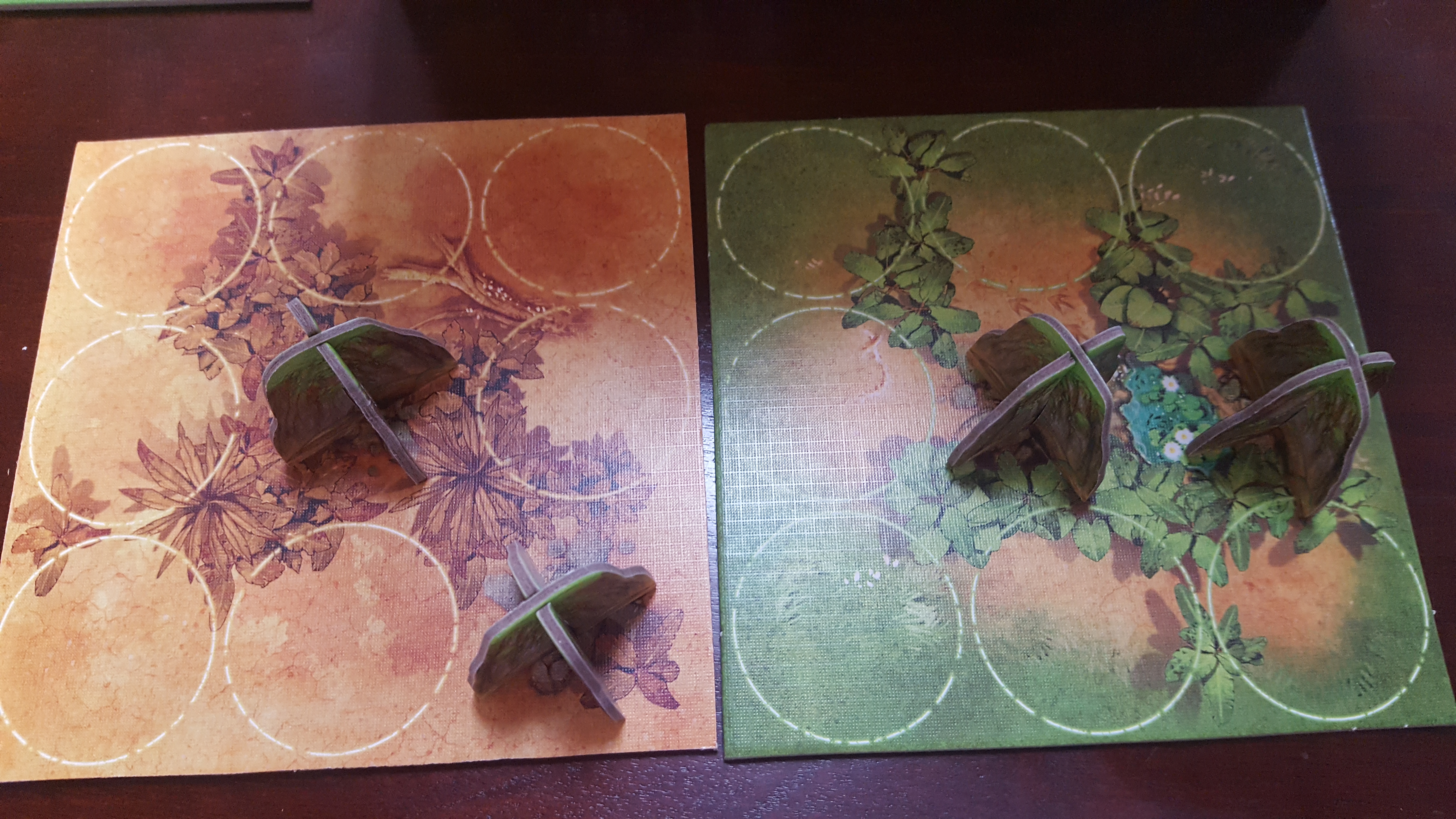
Two different terrain types – Jungle and Desert
The card play is really fun and challenging to master. Depending on the side that you’re playing, you need to figure out when it’s best for you to try to play the low cards and take advantage of the special abilities, or when you just need as many action points as possible, dropping the high values at the correct time. You are bound by the random draw though, but there are only nine cards, and you can always see your opponent’s discard pile to figure out which cards they still have left to play.
This is where the imbalance comes into the game, I think. It seems that the scientist’s cards are always useful, no matter what the game state is. No matter if they get to take the special ability or they get action points.
But on the raptor side, I always find myself getting stuck with the ‘one’ and ‘four’ card in my hand in the mid to late game. These cards call a certain number of baby raptors to the mother’s tile in a straight line, as long as they don’t hit any obstacles(boulders or other figures). So you need to manipulate the board so they are effective, which is difficult when you will also need to try to react to the scientist player’s actions.
They just end up being very situational. The saving grace is that the ‘one’ card also reshuffles your discard pile. So you can just throw that out there to get rid of it and refresh your deck. Even that has negatives though. Play that ‘one’ as the scientist player drops a ‘six’ valued card or higher, and that could easily be game over depending on board state.
Come mid to late game, these cards are clogging up your hand, so you might have baby raptors that are sleeping, and scientists only one or two spaces away from them. Meaning you can’t call them to you to get them away from the scientists, and you need to move the mother raptor next to them to wake them up. In the meantime, the scientists only need to move adjacent and spend an action point to capture the sleeping babies.
Maybe it’s time to switch to getting action points as the raptor then. Well, those two low valued cards aren’t going to help with that. I constantly found myself having to waste turns playing those cards, giving the scientist player tons of action points to shoot the mother raptor with sleeping darts or capture my babies.
Then when the raptor player finally gets to reshuffle and play their high cards again, you lose an action point per sleeping dart you’ve been hit with. This makes it pretty risky to be aggressive and go for the ‘eat all scientists’ win. But if you can get in there and wipe half of the board full of scientist figures, which is potentially very easy to do, you can clear a nice path for your babies to start moving off the board. Just be careful though, since the scientist player can pretty easily put more scientists back onto the board with their ‘two’ or ‘six’ valued cards.
There always seems to be a pretty severe tipping point in each game, where one player is dug into such a hole that it’s impossible for them to get out of it, barring a colossal misplay from their opponent.
Both sides are still incredibly fun to play though. As the raptor, you get the challenge of adapting to the setup of the board and figuring out how and when to use your special abilities and action points. As the scientists, you get to adapt to the movements of the raptor player more than the terrain and you get the satisfaction of outsmarting a killer dinosaur! So despite the imbalance between the two sides, I still really enjoy this game and highly recommend it to anybody looking for a light and highly interactive asymmetrical game.
One more game to cover in the first installment of the Two Player Showcase! Another card driven, semi dexterity game of sorts called Pagoda. The Emperor of China is visiting your province! You must honour him by building extravagant pagodas for his visit. Through card play, players will be constructing columns, floors and roofs of the pagodas to score points. When three pagodas are fully constructed, the game ends.
Each player starts the game with an architect board, an open display of five cards, and a hand of two cards. The starting open display consists of one card of each colour. These five colours correspond to the five colours of columns and floors that the players will be building. The open display is always known by both players, but a player’s hand of two cards is only known to them.
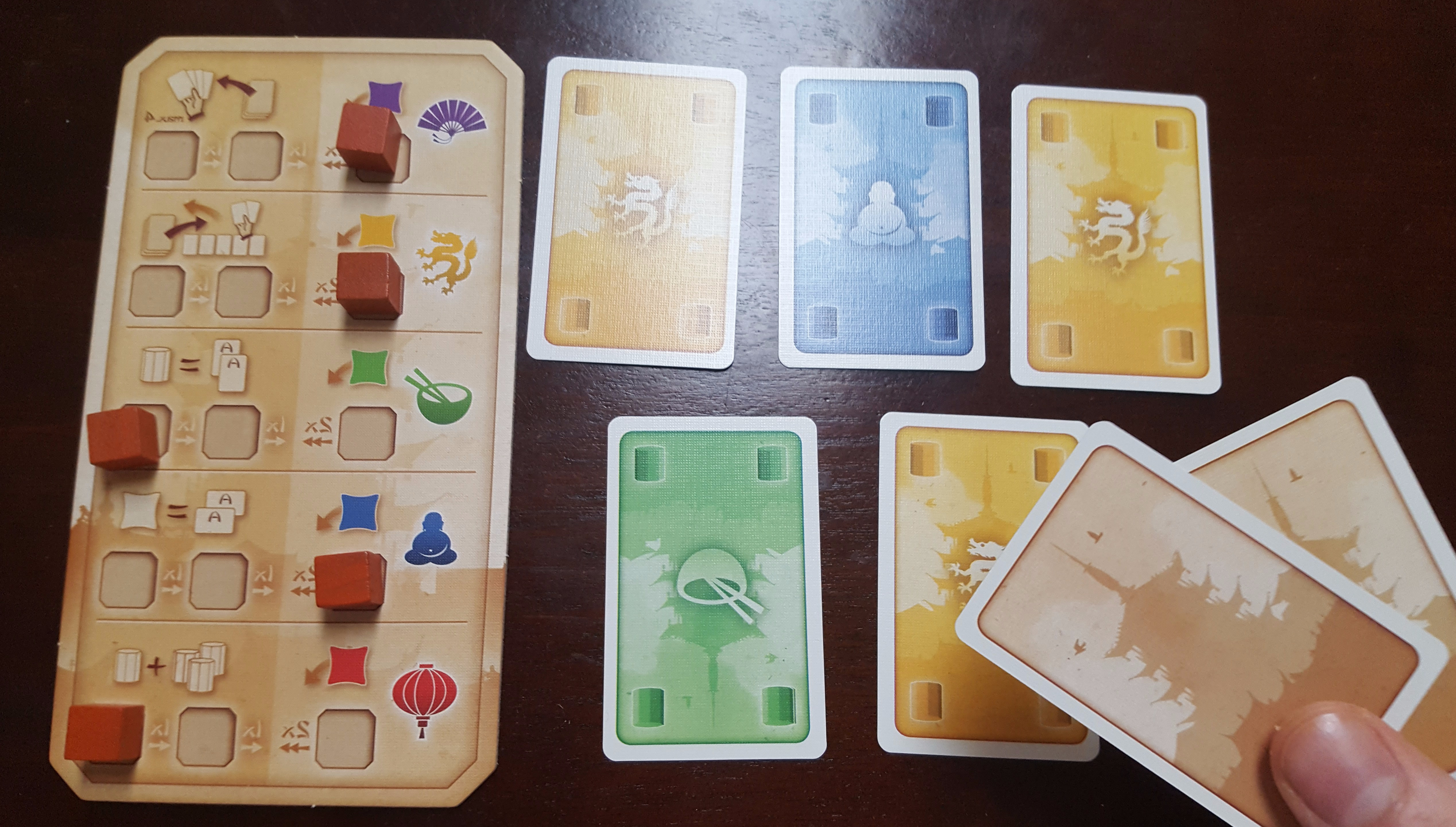
Architect board, open display and hand of cards
On a player’s turn, they take one to three column construction actions. To do this, a player chooses a card from their hand or open display and plays it. They then add a column of the corresponding colour to the board. Either adding to an existing pagoda, or starting a new one if available. Players may also place a floor or roof tile in the same manner. These do not cost a construction action. There are some colour limitations that players must abide by, however.
The game board has six, neutral starting spaces for pagodas at the beginning of the game. Any coloured column can be started on these neutral spaces, as long as all four columns of a floor are the same colour. When placing a floor or roof tile, the tile’s colour must match the colour of the columns that have previously been built. Each floor tile has a specific colour of column that can be built on it for the subsequent floor. Each colour of floor tile has one tile for each colour of column, for a total of twenty five floor tiles.
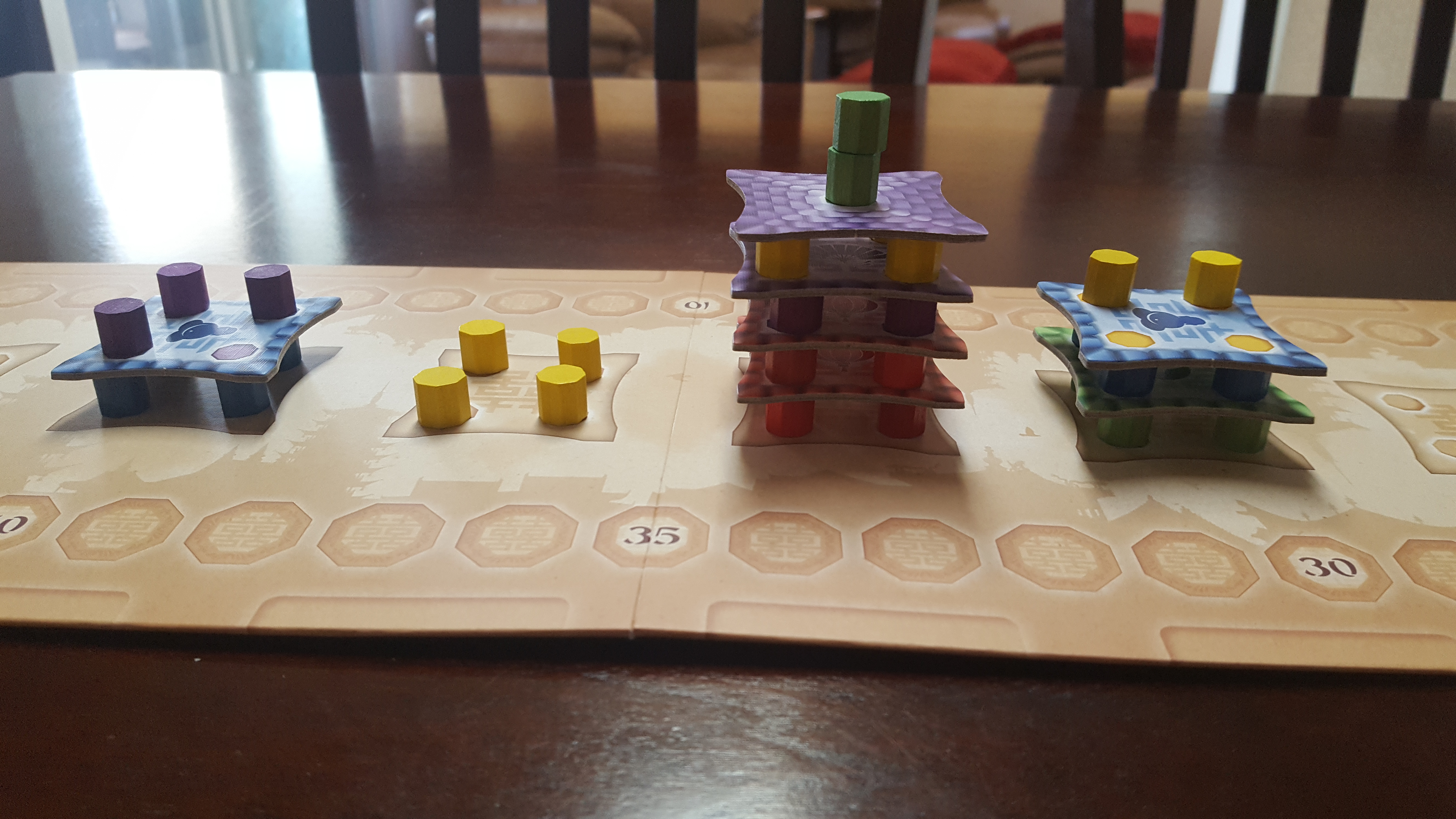
One pagoda complete!
When a player builds a floor tile, they gain two uses of a special ability, as marked on their architect board. There is one special ability per colour of floor tile. Players can use as many different special abilities as they have access to per turn. They may not use the same ability twice on the same turn. If there are four levels of columns constructed, the floor tile is then built as a roof tile.
When building a roof tile, players play a card like normal, but then choose a floor tile and turn it over. This is now a roof tile. The roof tiles show one column spot of a particular colour. To complete the roof, the player must be able to build two columns of the same colour. This is the rooftop. Building the rooftop only costs one construction action, but requires two cards of the same colour to be played. If a player can not build the roof tile and the rooftop in the same turn, they can not build the roof.
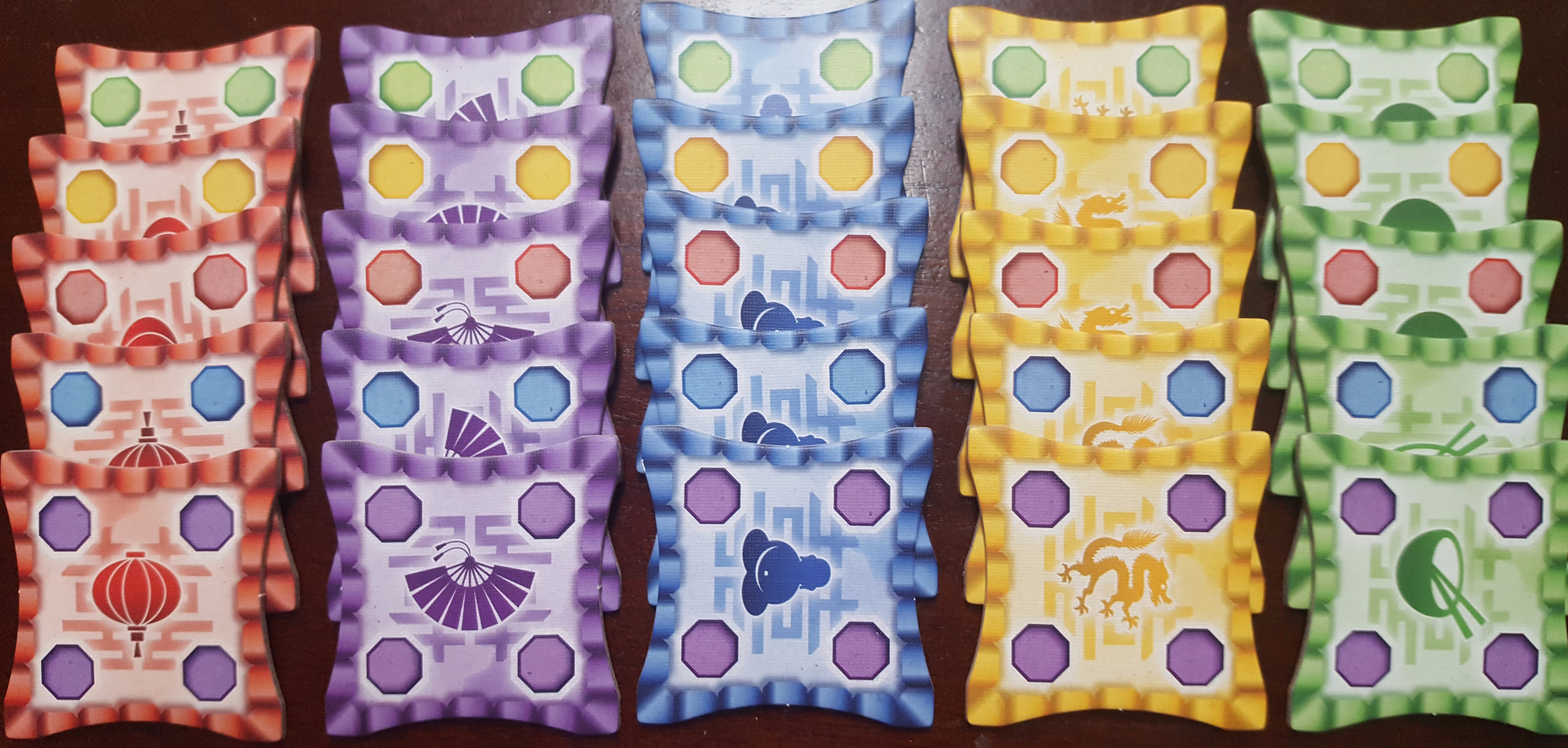
Floor/roof tiles
After a player has taken their construction actions, they refill their open display first, and then refill their hand of two cards, where applicable. Players score points whenever they construct something. Constructing a column scores you points equal to the level of the pagoda that is being constructed on. If you build a column on the third level, that column is worth three points. Every floor/roof tile constructed is worth one point. Building the rooftop, which completes a pagoda, is worth five points. The player with the most victory points wins.
Compared to Raptor, there is very, very little player interaction. The interaction comes with the open display of cards each player has. I think this is a really smart part of the game. Giving each player enough information to see what their opponent is able to do, but still with a touch of randomness and unpredictability.
The special abilities are a nice touch too. They help encourage the players to build new levels, giving their opponent opportunity for points as opposed to potentially slow rolling their turns and dragging out the game. Also, choosing to build the floor tiles gives you more control over the game as well, since you get to choose which colour of columns you want to be built for the next floor. So you can look at your opponent’s open display and choose a colour that they have very little, or none of.
Obviously the best part of this game is the physical construction of the pagodas. They definitely look pretty cool by the end of the game. And the pieces aren’t ridiculously tiny or fiddly when building the columns. Since you always have four of them before building another level on them, they never topple over. I’m incredibly clumsy and have never knocked one over. . . yet, anyways.
Honestly, there isn’t much to say about this game, good or bad. It’s a very simple, easy to play experience. It’s one of those peaceful playing games, you could easily play two games in about thirty five minutes. I like to have it in my collection for a nice wind down game after playing some more intense things, or vice versa, an easy way to start off a night and maybe ease a newer player into the world of two player games. I would recommend picking this up if you and your significant other or two player go to person is not into the more aggressive or cutthroat play experiences.
Next installment will cover some more abstract, chess like games. Onitama, The Duke and Hive. Hope you enjoyed!
L.

